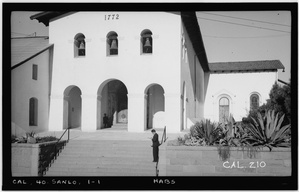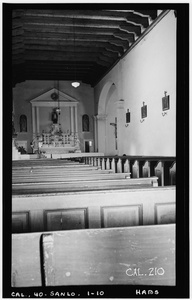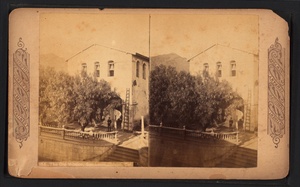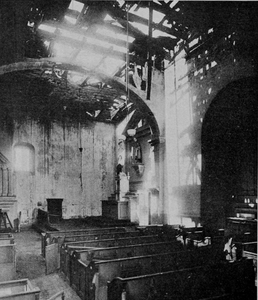Mission History
[This page began as a copy of the Mission's history website page.]
Facts in brief: The fifth California mission founded by Father Junipero Serra, Sept. 1, 1772. Named after Saint Louis, Bishop of Toulouse, France.
 the Mission, a few years after the front portico was restoredIn 1769, Fr Serra, a member of the Order of Franciscan Minors (O.F.M.), received orders from Spain to bring the Catholic faith to the Indigenous Peoples of Alta California. Mission San Diego was the first mission founded in Alta California that same year.
the Mission, a few years after the front portico was restoredIn 1769, Fr Serra, a member of the Order of Franciscan Minors (O.F.M.), received orders from Spain to bring the Catholic faith to the Indigenous Peoples of Alta California. Mission San Diego was the first mission founded in Alta California that same year.
On September 7–8, 1769 Gaspar de Portola traveled through the San Luis Obispo area on his way to rediscover the Bay of Monterey. The expedition’s diarist, Padre Juan Crespi, O.F.M., recorded the name given to this area by the soldiers as llano de los Osos, or the level of the bears (Bear Plain) as this was an area with an abundance of bears. Since then, various translations of the Crespi Diary have called this area La Canada de Los Osos (The Canyon of the Bears) which has been further mistranslated as the Valley of the Bears.
In 1770, Fr. Serra founded the second mission, San Carlos Borremeo, in Monterey which was moved to Carmel the following year. As supplies dwindled in 1772 at the then four missions, the people faced starvation. Remembering the Valley of the Bears, a hunting expedition was sent to bring back food in the summer of 1772. Over 25 mule loads of dried bear meat and seed was sent north to relieve the missionaries, soldiers, and neophytes (baptized Indigenous Peoples). Some of the meat was traded with the local people in exchange for edible seed. It was after this that Fr. Serra decided that La Canada de Los Osos would be an ideal place for the fifth mission. The area had abundant supplies of food and water, the climate was also very mild, and the local Chumash were friendly. With soldiers, muleteers, and pack animals carrying mission supplies, Fr. Serra set out on a journey to reach the Valley of the Bears. On September 1, 1772, Fr. Serra celebrated the first Mass with a cross erected near San Luis Creek. The next day, he departed for San Diego leaving Fr. Jose Cavaller, O.F.M., with the difficult task of building the mission. In 1773 Fr. Cavaller, five solders, and two neophytes began building what is today called Mission San Luis, Obispo de Tolosa.
Foundation Years: California as a Spanish Territory
After Fr. Serra left, the difficult task of actually building the mission remained. This was accomplished with the aid of local Chumash. Palisades were set up as temporary buildings, which were made simply from poles and tree boughs. However, due to fires in the first few years, adobe and tile structures were erected. The Church and Priest’s residence, the convento wing, were built by 1794. Many other structures made up the Mission in the early days: storerooms, residences for single women, soldiers barracks, and mills. The mission also had land for farming and raising livestock. The whole community of priests, neophytes, and soldiers needed to produce goods for their own livelihood.
 the interior of the church, photographed in 1936
the interior of the church, photographed in 1936
Development and Troubles
When the Mexican War for Independence broke out in 1810, all California Missions were virtually self-sufficient. Receiving few funds from Spain, building proceeded for a few years due to the prosperity of the Mission. Between 1810-1820 neophyte cabins, mill wheels, and a granary were built, the quadrangle was finished, and the pillars on the priest’s residence were changed from the original square adobe columns to the round shape.
After 1818, the Mission’s prosperity began to decline and by the 1840s there was little left of the community of earlier times. The buildings were crumbling and there were not sufficient funds to rebuild. In an “informe” (report to the Government written in 1830) Fr. Gil stated: “The hospital and portions of neophyte villages are in ruins and the rest of the village threatens to fall into ruins… the front of the Mission Church has to be taken down, because it threatened to tumble over”. In his 1832 “informe” he was even more dismal: “Every day the Mission structures are decaying more and more for want of sufficient hands to renovate them… the belfry mentioned last year has been demolished by rains therefore we built another of masonry.”
 the southern corner of the Mission, ca. 1885
the southern corner of the Mission, ca. 1885
Soon after Mexico won her independence from Spain (1821), the Missions were secularized by the Mexican Government, priests no longer managed the Missions, and many Mission lands were sold. Governor Pio Pico sold the San Luis Obispo Mission to Capt. John Wilson for $510 in 1845. During this time, buildings were appropriated for any use deemed necessary by the civil authorities. The Mission convento wing housed a school as well as a jail and first county courthouse.
 a stereogram image of the Mission, ca. 1890
a stereogram image of the Mission, ca. 1890
Since 1850
 interior of Mission after 1920 fire
interior of Mission after 1920 fire
After California became a part of the United States in 1850, the first California bishop, Joseph Alemany, petitioned the U.S. Government to return some of the Mission lands back to the Church. Since that time, there have been considerable civic and political changes and the Mission has undergone dramatic structural changes. In the 1880s the front portico/bell loft had to be removed as it was so weakened by an earthquake. At this time an effort was made to “modernize” the structures. The colonnades along the front of the convento wing were razed and both the Church and the residence were covered with wooden clapboard. A New England style belfry was added as well. These changes did work to protect the structure from further decay, and in the 1930s during the pastorship of Fr John Harnett the buildings underwent extensive restoration to transform them back to early-mission style. In 1893, an annex had been added to the right of the sanctuary and was extended in 1948.
The Name behind the Mission “San Luis Obispo de Tolosa”
The patron saint of the mission is Saint Louis, Bishop of Toulouse, France. Louis, born in 1274, the second son of King Charles of Naples. After being defeated in a war with Spain, Louis and his brother were sent, as hostages, to Spain for the release of their father. The brothers spent seven years in Spain, being instructed by Franciscan friars. Having absorbed the training, Louis decided to join the Order. After his release, he renounced his claim to the crown of Naples, joined the Order of Friars Minor, and was consecrated Bishop of Toulouse. Due to poverty and disease in the city, he fell ill and passed away at the young age of 23. He has always been very dear to the Franciscan Friars.
Click here for more information about Saint Louis of Toulouse.
Timeline of Events |
|
| 1772 | Mission founded by Father Junipero Serra, accompanied by Padre Jose Cavaller and Captain Pedro Fages on September 1st, 1772. |
| 1774 | De Anza Expedition stops here on first overland expedition from Mexico to San Francisco. |
| 1776 | Roof fire |
| 1778 | Fr. Serra receives permission to confirm from the Pope. He confirms 265 persons at Mission San Luis Obispo. |
| 1783 | Beginning of official informes, which include spiritual and agricultural reports. |
| 1784 | Fr. Serra dies; Fermin de Lasuen, O.F.M., replaces him as Padre Presidente. |
| 1789 | Fr. Cavaller dies and is buried in the Mission floor in front of the sanctuary. |
| 1790 | Fr. Miguel Giribet, O.F.M., appointed senior missionary. |
| 1793 | Present Mission Church completed. |
| 1798 | Fr. Antonio Martinez, O.F.M., appointed assistant to Padre Giribet. |
| 1800 | Building under Martinez: Permanent dwellings for families, a granary, weaving room, and 6 adobe houses. |
| 1800-1815 | Rancho de la Playa (Santa Margarita Asistencia). |
| 1810 | Beginning of Mexican War for independence against Spain. |
| 1812 | Mission renovation: re-plastering, paving. |
| 1820 | Mission bells arrive from Lima, Peru cast by Manuel Vargas. |
| 1821 | Mexico wins independence from Spain. |
| 1824 | Natives at Missions Santa Barbara, Santa Ines, and La Purisima revolt against civil authority. |
| 1824 | Mexican Congress decrees that all Californians must sign oath of allegiance to Mexico. |
| 1827 | Mexican Congress decrees that all Spaniards under 60 years old shall be expelled. |
| 1830 | Mexican Governor Echeandia arrests Fr. Martinez on a trumped up charge of treason, and exiles him outside of Mexican territories. |
| 1830 | Earthquake. |
| 1830 | Fr. Luis Gil y Taboada, O.F.M., assigned to take over the Mission. He died in 1833 and was buried in the floor before the sanctuary. |
| 1834 | Mexican Congress approves Secularization Act: All Mission lands become property of Mexico and subject to disposition. |
| 1835 | Inventory and formal possession of Mission buildings by Mexican Government. |
| 1842 | Fr. Ramon Abella, O.F.M., dies; last Franciscan at the Mission. |
| 1845 | “Governor” Pio Pico sells remaining Mission lands including church and Laguna Rancho sold to Captain John Wilson and partners Scott and McKinley. |
| 1846 | Commodore Sloat raises U.S. flag over Monterey, War with Mexico begins, Pio Pico is deposed and his grants are suspended. |
| 1847 | Governor Kearney issues a proclamation protecting religious institutions. |
| 1848 | Treaty of Guadalupe Hidalgo signed ending the Mexican-American War. |
| 1850 | California admitted as the thirty-first State. |
| 1850 | Joseph Sudoc Alemany named first Bishop of Monterey. |
| 1855 | Bishop Alemany’s claim to Mission lands upheld by U.S. Land Commission. |
| 1856 | San Luis Obispo incorporates as a town. |
| 1861 | Stagecoach runs between San Francisco and Los Angeles. |
| 1872 | Renovation of Mission in New England style begins: Tiles replaced by shingles. |
| 1875 | Sisters of the Immaculate Heart of Mary come to San Luis Obispo to staff a new school. |
| 1876 | San Luis Obispo re-incorporates as a “city”. |
| 1893 | Fr. Valentin Aguilere decides to enlarge Church, builds annex to the right of the sanctuary. |
| 1894 | San Luis Obispo reached by railroad, Southern Pacific builds Ramona Hotel. |
| 1901 | California State Polytechnic College established. |
| 1920 | Fire in Sacristy. |
| 1926 | Mission Central High School opens. |
| 1933 | Restoration of the Mission (back to Spanish style) begun by Fr. Harnett. |
| 1948 | Addition to the Annex in the Church is completed. This addition was funded by the Hearst Foundation. |
| 1970 | The Mission continues to be recognized as the center of the City of San Luis Obispo, with the dedication of Mission Plaza. |
| 1998 | Mission Web page goes online. The Mission approaches the 21st Century as a thriving Christian community with several active ministries. It is now a diocesan parish ministered by priests who carry on the work that Fr. Serra began. |
| 2003 | Mission Web Site dramatically revitalized. The parish now serves 2,200 families of the San Luis Obispo and surrounding communities with a variety of ministries. |



